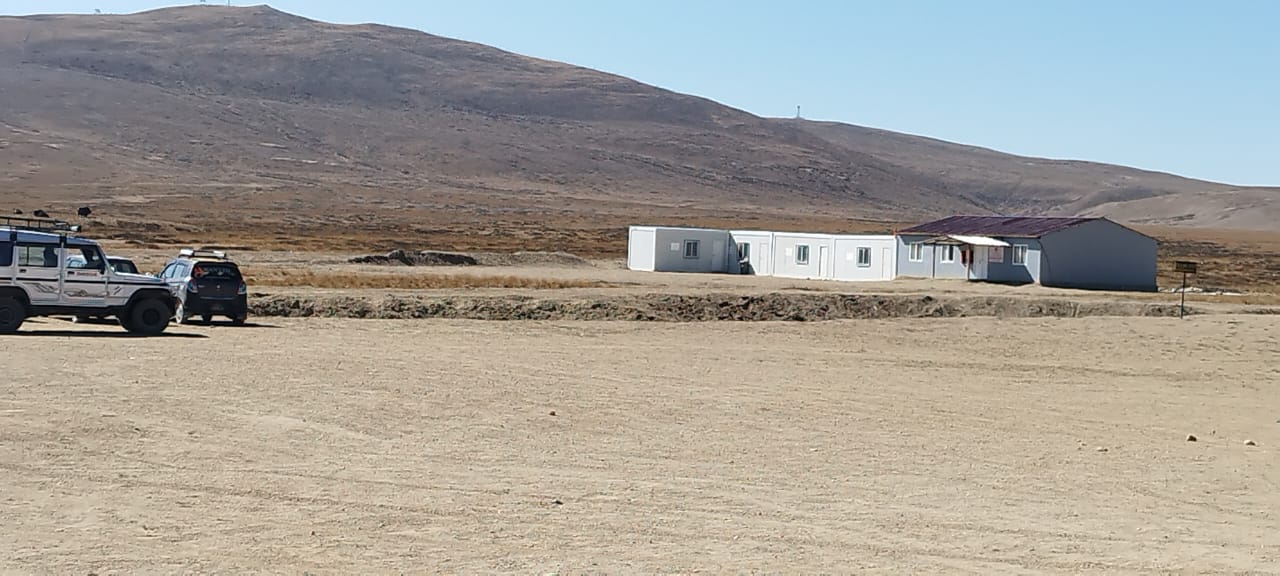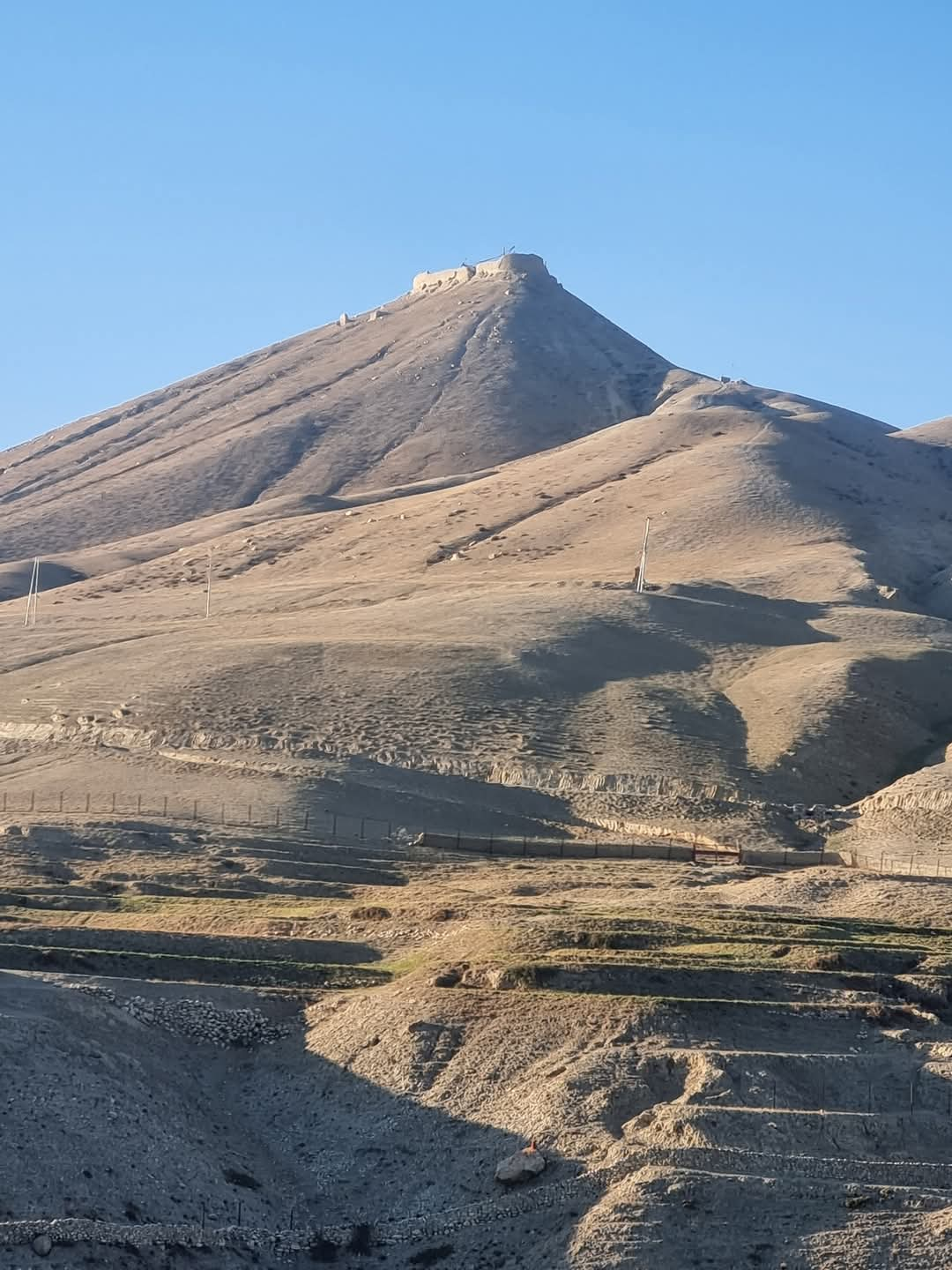

MUSTANG: The dream of setting foot on the land of Korala had come true. The pleasure was not unnatural. However, there was no expression of pleasure on any of our faces. A kind of disappointment could be sensed on everyone’s face. The unfortunate situation where Nepal and China could be directly compared at Korala (4,600 meters) was present. On that side were huge mansions, and on our side were temporary tents erected in the field. There were sufficient reasons for the skin on our foreheads to wrinkle and immediately form creases.
It was the last day of the first month of Nepali calendar. We (15 people, including the driver) were returning from the final stop of the Lo Manthang International Media Summit organized by the Nepal Press Union. The summit had concluded with the issuance of a declaration in Lo Manthang. The visit to Korala was a ‘bonus’ for us.
We understood that as the wind picked up in the Korala field, we had to leave from there. The snow on the surrounding mountains was also telling us the same thing. Snow is necessary for mountains, but I must say with sadness – the black rocks can be clearly seen on the high hills visible from here. While writing this, I remembered the words of the famous filmmaker Eric Valli, who introduced Nepal internationally through films like Honey Hunters of Nepal and Caravan, whom I recently met. Quoting Thinle, the immortal character of Caravan, he had said: “Along with the snow, the culture is also melting.”
To preserve the culture here, the mountains and snow must be saved. While I was here, I met many people who were worried about the decrease in snowfall. I have heard that there was plenty of snow in Mustang in late October. Thank goodness! During this journey, not only the snow and the mountains but also many other memories are safe in my mind.
I also remember the complaints of the local traders in Korala. According to them, when the then Home Minister Ramesh Lekhak inaugurated the Immigration Office at the Korala border on October 30, 2024, they were hopeful for an increase in economic activity. However, the service stopped after a few days. The long delay in operating the Immigration Office has affected the local businesses.
The Immigration Office on the Nepali side is locked. Customs, as well as Animal and Food Quarantine facilities, have not been established. Locals complain that the government’s lack of initiative in operating the Korala border is causing problems. Lo Manthang Rural Municipality Chairman Tasi Gurung understands that despite the hope that the border crossing and commercial transactions would become easier after the inauguration of the Immigration Office, it has not materialized. According to him, the security arrangement at the border is also not good. With no infrastructure other than a four-room tin-roofed building towards the south near the border, people cannot stay there. There is not even a place to take shelter when it rains.

A view of the Nepali side from the Korala border point (4,600m) on the Nepal-China border. Although the Nepal Immigration Office is located here, it has not been fully operational. Photo: Dharmendra Bihwal
“The border is 24 kilometers away from Lo Manthang. Although there is a police post (the last post in this area) 13 kilometers before the border in Nehchhung, the presence of police is weak,” Gurung had said. “There is no building for security personnel to stay, and even though poles have been erected, electricity has not reached there.” According to Gurung, if the border operates effectively, the residents of Lo Manthang and Lo-Ghekar Damodarkunda Rural Municipalities of Mustang could benefit. There is also no facility for drinking water and landline phones at the border, and if the border is operational, the arrival of Chinese tourists to Nepal will also be easier.
Due to the lack of buildings, there is a significant number of Nepalis who trade at the Korala border by setting up tents in the open field. Jigme Angma Gurung is one of them. Traders like her go to the Chinese side at 9 AM and return with goods by 2 PM. We learned that locals from Lo-Ghekar Damodarkunda and Lo Manthang Rural Municipalities of Upper Mustang are given entry passes, allowing them easy access to China, while special passes are arranged for others.
I had asked Jigme: Who are the buyers of the goods you bring here? Before I could finish my question, she had replied, “Our Nepali brothers and sisters, who come here and want to take souvenirs.” Locals buy and bring daily consumer goods, liquor, furniture, and clothing from the Chinese market.
There is a possibility of exporting goods like rice, buckwheat flour, beaten rice, noodles, herbs, and pashmina from the Nepali side.
The Korala border is also politically important. After the earthquake in 2015, this border was discussed along with Tatopani and Kerung, which are considered closer to Kathmandu. Jigme understands that if this border, which is considered comparatively easier geographically, comes into operation, the region can gain significant economic benefits.
The prosperity of Simraungadh in the past may also have been influenced by this trade connection. The boundary of ancient Mithila is defined as Koshi in the east, Gandaki in the west, Ganga in the south, and the Himalayas in the north.
While discussing trade between Nepal and China, I remembered the reference to the historically famous ‘Salt Trade Route’. In the car were myself and Press Union President Shiva Lamsal, as well as senior figures Harihar Birahi and Taranath Dahal, former presidents of the Federation of Nepali Journalists. Dahal’s study on this route is more extensive and authoritative. He said, “This is not just today; it is a traditional trade route connecting Tibet to present-day South Asia via the then Mithila and Vaishali.”
In a certain historical period, both Mithila and Vaishali practiced federalism as members of the Vajji Confederacy. According to one group of historians, the southern boundary of ancient Mithila extended to the Ganga. On this basis, Vaishali can also be considered a part of the greater Mithila Republic.
For a long time in the past, this was the main route for the transport of salt, wool, gold, and minerals, i.e., trade. Historians, including Roshan Kumar Jha, who have studied this subject, have stated that trade from Tibet to the plains proceeded through this route, and this route must have also centered the then capital of Mithila, Simraungadh. According to Jha, Simraungadh may have been the major trade center at that time. Jha has written about this in his recently published book, Simraungadh’s Connection with Nepal Mandal.
The Gandaki Provincial Government has prioritized the road connecting China’s Korala and India’s Triveni borders as the province’s lifeline and is moving forward with its upgrade. History is a witness that the present Triveni border was under the control of Mithila, i.e., Simraungadh. On this basis, the traditional relationship between Tibet and Simraungadh can be easily inferred. The great propagator of Buddhism, scholar Padmasambhava, is also estimated to have reached Tibet via this very route. Not only this, but the Kerung border also connects Mithila, not just Korala. The Kerung road’s connection is also estimated to be linked to Simraungadh via the current Thori.

A mountain view seen from Lo Manthang in Upper Mustang. Lo Manthang, the main settlement of the Lowa community, was established as the capital of a powerful kingdom in the past. Photo: Dharmendra Bihwal
The prosperity of Simraungadh in the past may also have been influenced by this trade connection. The boundary of ancient Mithila is defined as Kosi in the east, Gandaki in the west, Ganga in the south, and the Himalayas in the north. The source of the Gandaki River, the Kaligandaki, originates in Mustang (Damodar Kunda). The Shaligram of Kaligandaki is worshipped as Lord Narayan in every Maithil house. Based on this, it can be assumed that at some point in history, the boundary of Mithila may have extended to Damodar Kunda. Tibet and Mithila can be assumed to be two bordering states. Researcher Jha says, “It would not be surprising if it were said that the famous Chinese traveler Xuanzang also used this route.”
The car was steadily moving forward. I, meanwhile, was attempting to analyze the interrelationship between my Maithil society, Simraungadh, Gandaki, Shaligram, Muktinath, and Manasarovar.
We had passed the Nhechhung police post and reached Nhechhung, the last village on the Nepali side. We had not entered this settlement when we were going to Korala. Now, there was talk of fulfilling that desire. Small, low houses. The houses here look different from those in Lo Manthang. Perhaps because it is at a higher altitude than Lo Manthang (3,850 meters).
Looking at the settlement, it immediately felt like Lo Manthang was a bit more prosperous than Nhechhung. The intensity and coldness in the air are palpable. Huge mountains nearby have not left us, nor have they blocked the road. Just then, someone inside the car pointed to those hills, brought up the Khampa rebellion, and argued that there might be bunkers in the area. At this time, Union President Lamsal inquired about the uranium mine.
I remember senior Birahi saying in a suggestive manner, “There is a lot of talk and speculation, but we must look for evidence of confirmation.”
The Korala border is considered a suitable route for Hindus to visit Kailash and Mansarovar, centers of faith. Dhongwasen is 40 kilometers from Lo Manthang towards Tibet. After covering a distance of about 600 kilometers from there, one can reach Manasarovar. Local experts say that if the border operates smoothly, this could become the shortest and best route from Nepal to reach Kailash Manasarovar.
The Korala border was completely closed during the Covid-19 pandemic in 2020. It came into operation four years later, on November 13, 2023. Before that, cross-border trade fairs used to be held at the border twice a year, in May and in Autumn. However, the trade fair has not taken place since the pandemic.
The car was steadily moving forward. I, meanwhile, was attempting to analyze the interrelationship between my Maithil society, Simraungadh, Gandaki, Shaligram, Muktinath, and Manasarovar. I was asking myself: “Was the influence of Mithila truly extended up to here?”